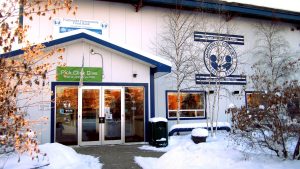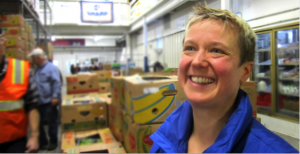- Nobody Should Go Hungry, No Questions Asked - December 4, 2017
By Pete Van Nort
They began lining up early at the Presbyterian Church on the day before Thanksgiving. By the time the doors opened at 9 a.m., hundreds were standing in line, braving temperatures slightly above zero, to pick up a free seasonal food box.
It’s a scene that has been repeated in town for almost three decades. The Fairbanks Community Food Bank along with several churches and the Salvation Army each year distribute Thanksgiving food boxes to the less fortunate. Organizers figure they gave away 2,200 boxes of food this year, a 10 percent increase from last year.

The recipients included young families with children, senior citizens and people of every ethnic background. They each received a modest care package: a free turkey, canned cranberries, stuffing and pumpkin pie. The food was available for anyone who showed up – no questions asked. Many left excited, looking like they were holding the winning ticket to the Nenana Ice Classic.
“When we were young we’d have spruce chicken and geese for the holidays,” said James, a 67 year old construction worker from the village of Hughes, who participated in the food giveaway one other time. “In Alaska we take care of each other, like [when you break down] on the highway.”
The Thanksgiving food distribution is a bittersweet reminder that many in Fairbanks and others around the nation struggle daily to make ends meet. Sociologists refer to those who don’t have access to enough healthy food as being food insecure.
The truth is hunger in American is a problem that impacts 12 percent of the population, and not just around the holidays. According the U.S. Department of Agriculture over 16 million Americans were unable to provide enough food to feed their families in 2016.
While the Presbyterian Church and about 30 other local agencies such as the Rescue Mission, Stone Soup Kitchen and Meals on Wheels assist in the mission of feeding the area’s hungry, the Food Bank serves as the main clearing house for charitable food distribution in the Fairbanks area.
From humble beginnings during the post-pipeline economic slump of the 1980s the Food Bank has grown into an impressive daily operation located in a 25-thousand square foot warehouse in south Fairbanks.
“Last year alone we provided 365,000 meals to Interior Alaska,” said Anne Weaver the Food Bank’s executive director. “We did that by collecting 2.3 tons of donated food each day, 90-percent of which came from local grocery stores and the balance from churches, school food drives, local businesses and individuals.”
In addition to the annual Thanksgiving distribution, the Food Bank provides meals to the less fortunate on an on-going basis, year round through six different programs that benefit all ages, from the very young to the elderly. Forty percent of the agency’s recipients are children and 20 percent are seniors on a fixed income.

“We don’t know if it’s going to be 30 households or 60 each day, Weaver said recently. “It’s a really fun daily puzzle putting together the incredible work from the community.”
She is quick to point out the success of the operation is due in large part to the support from Fairbanks. In a typical year Weaver says it takes 19-thousand volunteer hours to keep the machinery of distribution moving.
Last year was an especially challenging time for the Food Bank according to Weaver. An increase in unemployment due to oil industry cutbacks, university layoffs and a $1,000 cut in the amount of the Permanent Fund Dividend all led to more demand and fewer donations.
“When folks don’t have jobs more people have a need [for our services] but less people can fund it,” she explained.
Although the annual Thanksgiving food distribution is over Weaver said they are still scrambling to collect enough food for the anticipated demand at Christmas and during the first few months of the coming year, when financial donations are typically slower.
“Alyeska Pipeline Service Company matched all cash contributions from the community up to $6,500 in November and Kinross Fort Knox will match contributions up to $10,000 in December,” she said.
Despite being involved in a program that literally operates hand-to-mouth and can, at times show the darker side of humanity, Weaver remains upbeat – choosing to look at the positive benefits of her position.
“With all the bad news in the world,” she said, “it’s refreshing to see what the community does to help the less fortunate.”
She recently related the story of a family with five children who had a storm-related power outage. The family lost all the food in their refrigerator and didn’t have the funds to replace the spoiled items. Weaver said the family was provided with a 3-day supply of meals from the Food Bank to help get them back on their feet.
“A few days later they came back into the office and one of their little girls pulled out a dollar bill and some change and proudly laid it on the counter. She told us this was a thank you for helping out her family,” said Weaver.
